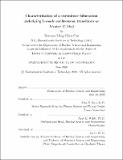| dc.contributor.advisor | John E. Rice. | en_US |
| dc.contributor.author | Cao, Norman Ming-Chen. | en_US |
| dc.contributor.other | Massachusetts Institute of Technology. Department of Nuclear Science and Engineering. | en_US |
| dc.date.accessioned | 2020-09-15T21:51:43Z | |
| dc.date.available | 2020-09-15T21:51:43Z | |
| dc.date.copyright | 2020 | en_US |
| dc.date.issued | 2020 | en_US |
| dc.identifier.uri | https://hdl.handle.net/1721.1/127313 | |
| dc.description | Thesis: Ph. D., Massachusetts Institute of Technology, Department of Nuclear Science and Engineering, 2020 | en_US |
| dc.description | Cataloged from the official PDF of thesis. | en_US |
| dc.description | Includes bibliographical references (pages 153-164). | en_US |
| dc.description.abstract | Empirical energy confinement scalings play a crucial role in the design of tokamak fusion reactors, measuring how quickly energy is transported by turbulence from the fusion-producing core to conduction loss at the edge. Unfortunately, experiments often exhibit discontinuous changes in scaling behavior as the plasma parameters are varied, termed confinement transitions. Navigating these transitions requires an understanding of the physical origin and limits of confinement scalings, and is crucial for retiring the physics risk of extrapolating empirical results to future reactors. This thesis explores the connection between two universally observed transitions in tokamak transport: the Linear to Saturated Ohmic Confinement (LOC/SOC) transition and the concomitant intrinsic rotation reversal. Analysis and modeling of rotation reversal hysteresis experiments show that a single turbulent bifurcation underlies both transitions on Alcator C-Mod. | en_US |
| dc.description.abstract | Plasmas on either side of the reversal exhibit different toroidal rotation profiles and therefore different turbulence characteristics despite profiles of density and temperature which are indistinguishable within measurement uncertainty. Elements of this bifurcation are also shown to persist for auxiliary heated L-modes. Within a reduced quasilinear transport model, the deactivation of subdominant (in linear growth rate and contribution to heat transport) ion temperature gradient (ITG) and trapped electron mode (TEM) instabilities is identified as the only possible change in turbulence across the reversal which is consistent with the measured profiles and inferred heat and particle fluxes. Experimental constraints on a possible change from strong to weak turbulence, outside the description of the quasilinear model, are also discussed. | en_US |
| dc.description.abstract | These results indicate an explanation for the LOC/SOC transition that provides a mechanism for the hysteresis through the dynamics of subdominant modes and changes in their relative populations, and does not involve a change in the most linearly unstable ion-scale drift-wave instability. This work highlights the importance of considering the dynamics of the entire mode spectrum, and not just the dominant modes, in making predictions about transport and confinement regimes. | en_US |
| dc.description.statementofresponsibility | by Norman Ming-Chen Cao. | en_US |
| dc.format.extent | 164 pages | en_US |
| dc.language.iso | eng | en_US |
| dc.publisher | Massachusetts Institute of Technology | en_US |
| dc.rights | MIT theses may be protected by copyright. Please reuse MIT thesis content according to the MIT Libraries Permissions Policy, which is available through the URL provided. | en_US |
| dc.rights.uri | http://dspace.mit.edu/handle/1721.1/7582 | en_US |
| dc.subject | Nuclear Science and Engineering. | en_US |
| dc.title | Characterization of a turbulence bifurcation underlying L-mode confinement transitions on Alcator C-Mod | en_US |
| dc.type | Thesis | en_US |
| dc.description.degree | Ph. D. | en_US |
| dc.contributor.department | Massachusetts Institute of Technology. Department of Nuclear Science and Engineering | en_US |
| dc.identifier.oclc | 1191905526 | en_US |
| dc.description.collection | Ph.D. Massachusetts Institute of Technology, Department of Nuclear Science and Engineering | en_US |
| dspace.imported | 2020-09-15T21:51:42Z | en_US |
| mit.thesis.degree | Doctoral | en_US |
| mit.thesis.department | NucEng | en_US |
